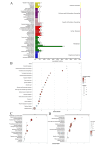Toxicological Mechanisms of Uranium-Induced Apoptosis in HK-2 Cells: A Proteomics and Metabolomics Study
- PMID: 40863976
- PMCID: PMC12389946
- DOI: 10.3390/toxics13080699
Toxicological Mechanisms of Uranium-Induced Apoptosis in HK-2 Cells: A Proteomics and Metabolomics Study
Abstract
The rapid development of the nuclear industry and mining has increased environmental radioactive contamination, posing potentially ecological risks and health threats to humans. Uranium compounds are known to exhibit selective nephrotoxicity, but their toxicological processes and mechanisms still remain poorly understood and controversial. In this study, the uranyl-induced toxicity in human renal tubular epithelial cells (HK-2) were explored using flow cytometry, DAPI staining, and comet assays. Our results demonstrate that uranium exposure primarily triggers apoptosis. Kyoto Encyclopedia of Genes and Genomes pathway enrichment and protein-protein interaction (PPI) analyses revealed significant associations with DNA damage. Moreover, aberrant expression of ABC transporters (e.g., ABCB7) and mitochondrial-related proteins confirms uranium-induced mitochondrial dysfunction. Gene Ontology functional annotation implicated extrinsic apoptotic signaling pathways in uranium-induced cell death. The downregulation of the UBL5 protein also pointed to endoplasmic reticulum stress-mediated apoptosis. In summary, uranium exposure can induce the apoptosis of HK-2 cells through intrinsic pathways by damaging DNA and mitochondria and disrupting protein synthesis, with secondary contributions from endoplasmic reticulum stress and extrinsic apoptotic signaling.
Keywords: HK-2 cell; apoptosis; metabolomics; proteomics; uranium.
Conflict of interest statement
The authors declare that they have no known competing financial interests or personal relationships that could have appeared to influence the work reported in this paper.
Figures








References
Grants and funding
LinkOut - more resources
Full Text Sources

